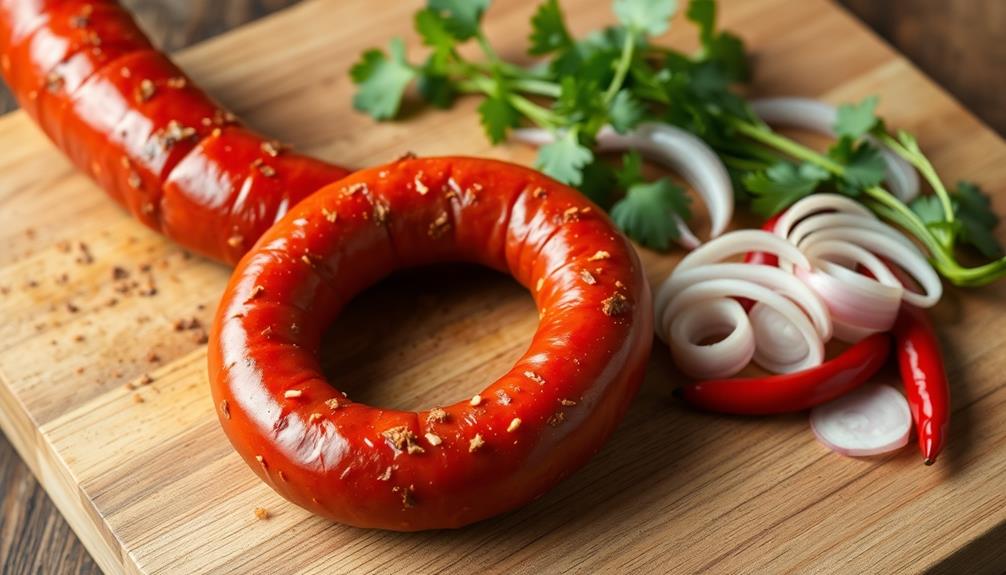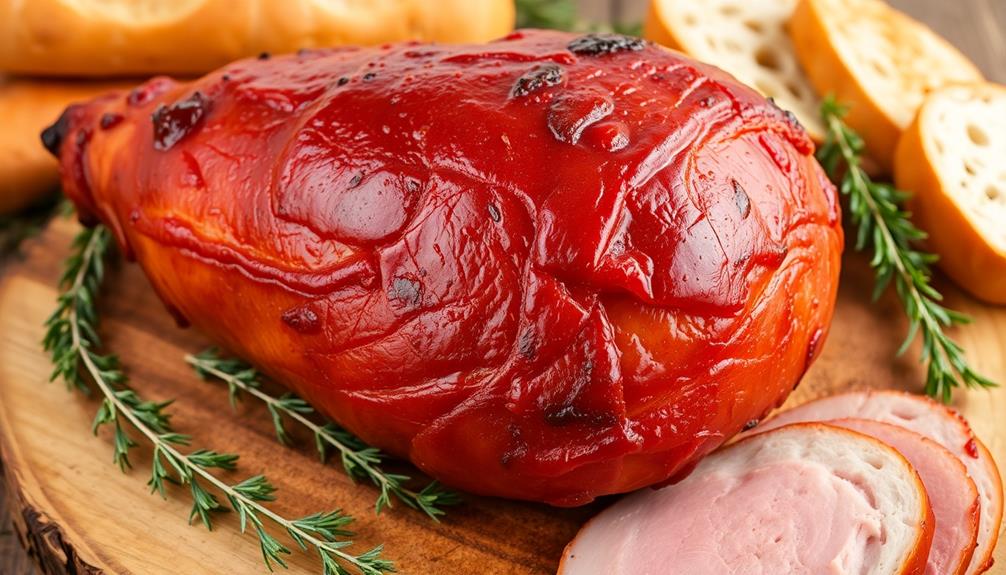Cachopo is a beloved traditional Spanish dish from the Asturias region. It features tender beef or veal stuffed with savory ham and melted cheese, then breaded and fried or baked to golden perfection. This beloved dish reflects the rich culinary heritage of Asturias, often served at gatherings and celebrations to bring people together. The key is pounding the meat to tenderize it, stuffing it with the tasty fillings, breading it, and then frying or baking it to achieve the perfect crispy texture. Cachopo offers a delightful combination of flavors and textures, making it a true culinary delight. Discover more about this cherished Spanish specialty and its captivating history.
Key Takeaways
- Cachopo is a traditional dish originating from the Asturias region of Spain, featuring thin slices of beef or veal stuffed with ham and cheese.
- The dish has a rich culinary heritage, with preparation methods passed down through generations, resulting in unique family variations.
- Cachopo can be either fried or baked, offering distinct textures and flavor profiles, and is often served with dipping sauces.
- The dish is a beloved part of Asturian culture, frequently enjoyed during gatherings and celebrations, showcasing the region's communal dining traditions.
- Cachopo is high in protein due to the meat and cheese content, but the nutritional values can vary based on the cooking method and ingredients used.
History
The origins of cachopo can be traced back to the Asturias region of northern Spain. This traditional dish has been a staple in the area for centuries, reflecting the rich culinary heritage of the region.
Cachopo consists of two thin slices of beef or veal that are stuffed with ham and cheese, then breaded and fried to create a crispy, golden exterior. The combination of the tender meat, savory fillings, and crunchy coating makes for a truly delectable experience.
Over time, cachopo has become a beloved part of Asturian culture, often served at family gatherings, festivals, and celebrations.
The preparation of this dish is a time-honored tradition, passed down through generations, with each family having their own unique twist on the recipe.
Whether enjoyed as a main course or a shared appetizer, cachopo remains a beloved and integral part of the Asturian culinary landscape.
Recipe
Cachopo is a traditional dish from Asturias, Spain. It consists of two thin veal or beef fillets, stuffed with a variety of ingredients, then breaded and fried.
The dish is believed to have originated in the 19th century, as a way to make the most of limited resources. Over time, the recipe has evolved, with different regions and families developing their own unique variations.
Ingredients:
- 2 thin veal or beef fillets
- 100g ham, diced
- 100g cheese, grated
- 2 eggs, beaten
- 1 cup breadcrumbs
- Vegetable oil for frying
- Salt and pepper to taste
Instructions:
In a skillet, fry the ham until lightly browned. Remove from heat and mix with the grated cheese.
Lay the veal or beef fillets flat and season with salt and pepper. Spread the ham and cheese mixture over one fillet, then top with the other fillet to create a sandwich.
Dip the sandwich in the beaten eggs, then coat it evenly with the breadcrumbs.
Heat the vegetable oil in a deep pan or fryer to 350°F (175°C). Carefully add the breaded cachopo and fry for 3-4 minutes per side, or until golden brown.
Drain on a paper towel-lined plate and serve hot.
Tips:
To ensure the fillets cook evenly, you may want to pound them thin before stuffing.
Additionally, you can experiment with different fillings, such as mushrooms, roasted peppers, or Iberian ham, to create your own unique variation of this classic dish.
Cooking Steps
First, you'll need to pound the meat to tenderize it.
Next, stuff the meat between two slices to create the cachopo.
Then, fry the cachopo until it's golden brown and bake it until it's nice and crispy.
Step 1. Pound Meat to Tenderize
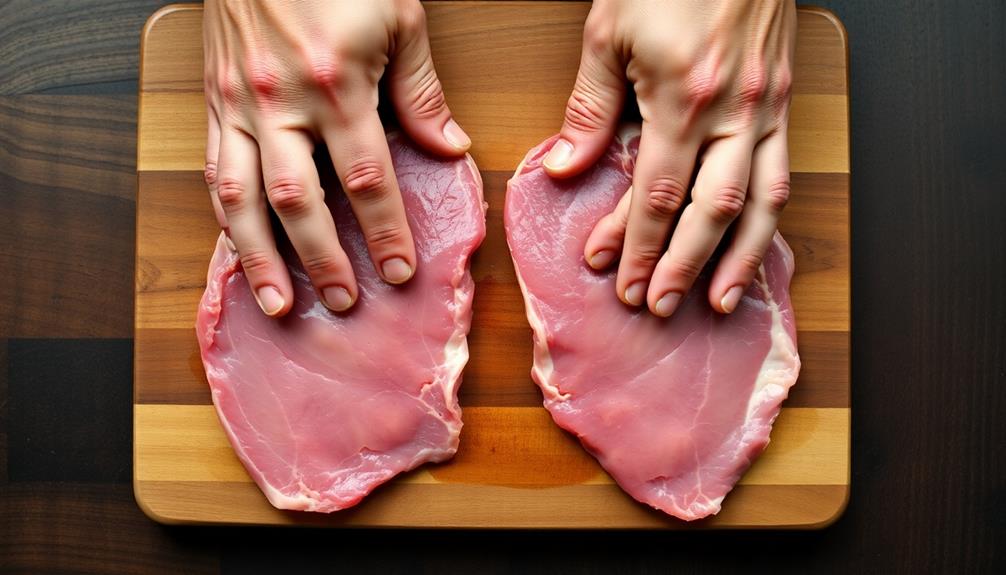
To tenderize the meat, grab a sturdy mallet and firmly pound the cachopo on both sides. This step is crucial for breaking down the tough fibers and making the meat more tender and easy to chew.
Apply even pressure as you pound, turning the cachopo over to ensure even tenderization. Take your time and don't be afraid to put some muscle into it!
Once the meat is nicely tenderized, you can move on to the next step of assembling your cachopo.
Remember, the more you work the meat, the more tender it will become. This extra attention to detail will pay off in the final dish, giving you a juicy and flavorful cachopo that melts in your mouth.
Enjoy the satisfying thud of the mallet and the transformation of the meat as you prepare this traditional Spanish delicacy.
Step 2. Stuff Meat Between Two Slices
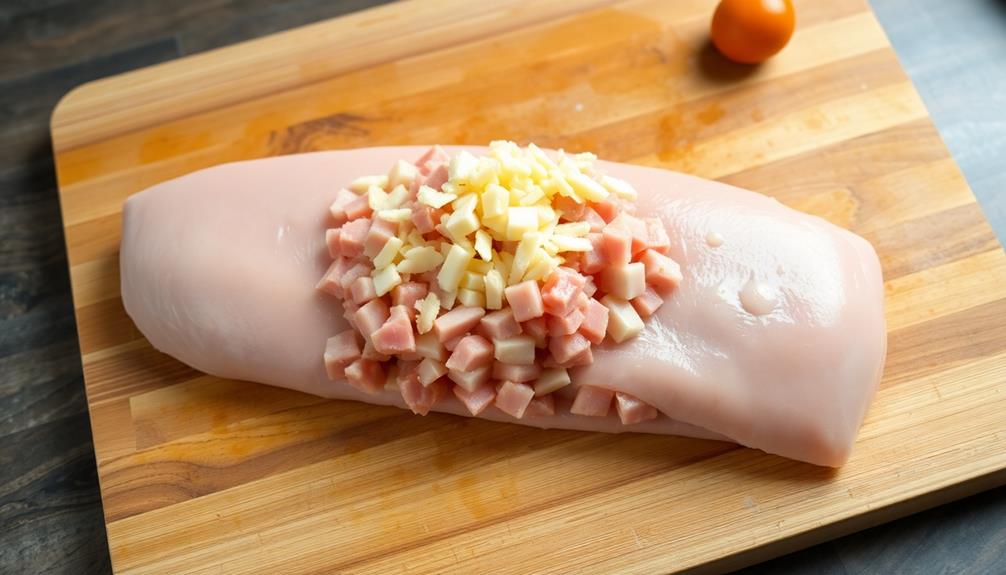
With the meat now tenderized, it's time to prepare the next step in creating your cachopo masterpiece.
Take the thinly pounded beef and place it between two slices of bread or pastry. This creates a delicious sandwich-like filling that'll be the star of your dish.
Next, stuff the meat-filled "slices" with your desired cheese and any other fillings, like sautéed mushrooms or roasted peppers. Be generous with the fillings, as they'll melt together beautifully.
Secure the stuffed meat with toothpicks or skewers to keep it all together.
Now, it's time to bread and fry your cachopo. Dip the stuffed meat into beaten eggs, then coat it in breadcrumbs or panko.
Carefully lower the breaded cachopo into hot oil and fry until golden brown and crispy on all sides. Drain on a paper towel-lined plate, then serve piping hot.
Enjoy your savory, indulgent cachopo, a true taste of Spanish culinary tradition!
Step 3. Fry the Cachopo Until Golden

The final step in creating your mouthwatering cachopo is to fry it until golden brown and crispy.
Heat a generous amount of oil in a large skillet or pan over medium-high heat. Gently place the stuffed meat into the hot oil, being careful not to overcrowd the pan. Fry the cachopo for 4-5 minutes per side, turning occasionally, until the exterior is a beautiful golden color.
Once the cachopo is perfectly fried, transfer it to a paper towel-lined plate to drain any excess oil. Allow it to rest for a minute or two before slicing into it.
The exterior should be delightfully crisp, while the interior remains tender and juicy. Serve your freshly fried cachopo hot, garnished with a sprinkle of chopped parsley or a drizzle of your favorite sauce.
Enjoy this incredible dish, a true celebration of Spanish culinary traditions.
Step 4. Bake the Cachopo Until Crispy
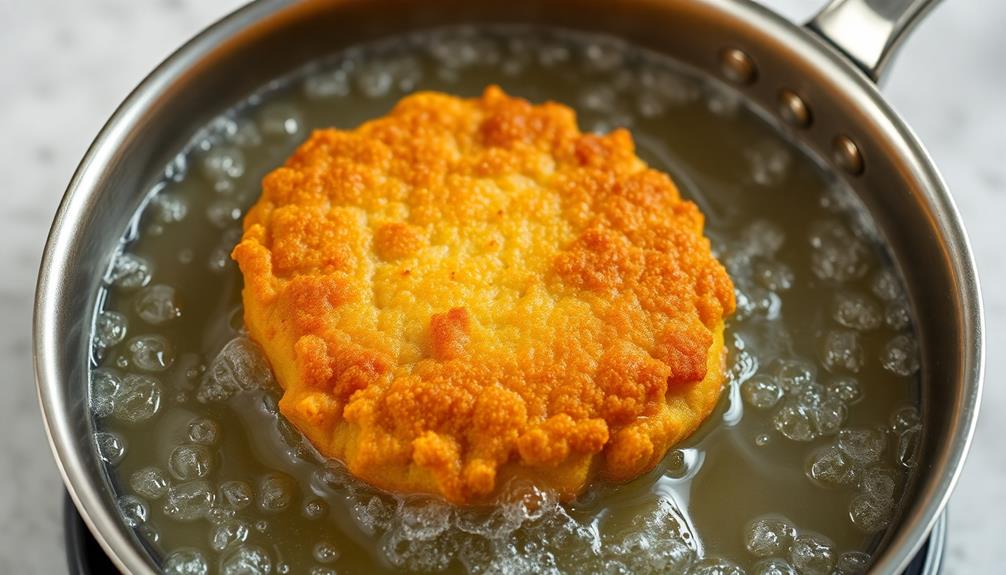
Alternatively, you can bake the cachopo to achieve a crispy exterior. Preheat your oven to 400°F (200°C).
Prepare a baking sheet by lining it with parchment paper or a silicone baking mat. Place the prepared cachopo on the baking sheet, making sure it's not touching the sides.
Brush the top of the cachopo with a thin layer of olive oil or melted butter. This will help it get that delightful golden-brown color.
Bake for 25-30 minutes, flipping the cachopo halfway through the cooking time. Keep an eye on it to ensure it doesn't burn.
Once the cachopo is golden-brown and crispy on the outside, it's ready to be enjoyed. Serve it hot, accompanied by your favorite sides or sauces.
The baked cachopo offers a delightful contrast of a crispy exterior and a tender, juicy interior. This method is perfect for those who prefer a healthier cooking option or want to avoid the messiness of frying.
Step 5. Serve the Cachopo Hot

Once the cachopo has reached its golden-brown and crispy perfection, it's time to serve it up hot. Transfer the sizzling masterpiece from the oven to a large serving platter. Be careful, as the dish will be incredibly hot! Arrange the crispy outer breading and tender, juicy filling neatly on the plate.
Serve the cachopo immediately, while it's piping hot. This ensures the breading maintains its perfect crunch and the cheese inside is still melted and gooey. Accompany the cachopo with a side of your favorite dipping sauce, such as a zesty tomato or creamy garlic aioli. The contrast of the hot, savory cachopo with the cool, flavorful sauce is simply divine.
Invite your guests to dig in and enjoy this Spanish delicacy at its best. The steaming, flavorful cachopo is sure to be the star of the meal, so savor every bite.
Final Thoughts
Cachopo, a beloved dish in Spanish cuisine, leaves a lasting impression on all who indulge in its flavorful layers. After savoring the crisp breading, the tender meat, and the melty cheese, you're left with a deep appreciation for the culinary artistry on your plate. To complement the rich and indulgent flavors of cachopo, many choose to pair it with a glass of sparkling wine from Cava. The effervescence and lightness of these wines provide a perfect contrast to the hearty dish, enhancing the overall dining experience. The combination of cachopo and sparkling wines from Cava creates a sensorial journey that leaves a lasting impression on food enthusiasts around the world.
As you reflect on your Cachopo experience, you can't help but feel a sense of satisfaction. This dish is more than just a meal – it's a celebration of Spanish culture, a convergence of textures and flavors that transport you to the heart of the country.
Whether enjoying it during a lively fiesta or a quiet family gathering, Cachopo has a way of bringing people together and creating lasting memories.
As you consider your final thoughts, remember that the true essence of Cachopo lies not just in its delicious taste, but in the joy and conviviality it inspires. Savor every bite, and let the flavors linger, for Cachopo is a culinary treasure that deserves to be cherished.
Frequently Asked Questions
What Are the Health Benefits of Eating Cachopo?
Eating a balanced diet with nutritious foods can provide numerous health benefits. It can support a healthy immune system, maintain strong bones and muscles, and promote overall well-being. Incorporating a variety of nutrient-dense ingredients into your meals is key.
Where Can I Find the Best Cachopo in Spain?
As for the best cachopo in Spain, you'll find an abundance of delicious options throughout the country. From traditional haunts to modern eateries, explore your local recommendations to discover the most mouthwatering cachopo that suits your taste buds.
Is Cachopo a Traditional Dish in Other Countries?
While cachopo may be a traditional Spanish dish, it's not necessarily common in other countries. However, you may be able to find similar meat-based dishes with local variations across different cuisines if you explore further.
Can I Make Cachopo at Home With Simple Ingredients?
Can you make it at home with simple ingredients? Absolutely! With a few basic items, you can whip up this delicious dish right in your own kitchen. It's easier than you might think.
How Long Does Cachopo Typically Take to Prepare?
It typically takes about 1-2 hours to prepare cachopo at home, depending on your experience level. The process involves several steps, from preparing the beef filling to breading and frying the dish.

